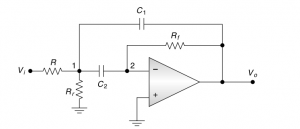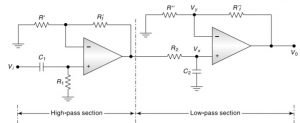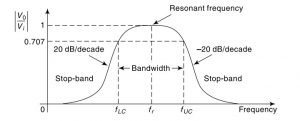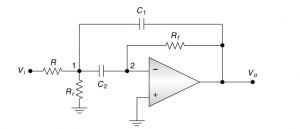- Definition of Active Band Pass Filter
- Passband & Stopband
- How does an active bandpass filter work
- Types of the active bandpass filter
- Frequency response & time response
- The transfer function of active BPF
- Applications of active BPF
- Advantages
- Comparison between Active Band Pass Filter & Active Band Stop Filter
- Short note on All-Pass Filter
Definition of bandpass filter:
“A Band Pass Filter (BPF) is an electronic filter or device which passes frequencies within a certain range and rejects or attenuates frequency outside the particular range.”
Now an Active Band Pass Filter is a filter, consists of active components and has a passband between two cut-off frequencies, fce (lower cut-off frequency), and fcu (upper cut-off frequency) such that fcu>fce. All the other frequencies outside the passband are attenuated.
Passband – “Pass-band is the particular range of frequencies which a filter pass through inside it.”
Stopband – “A filter always carries filters within a given band, and rejects the frequencies which are below the given range. This particular range is known as a Stopband”.
Working principle of an Active Band Pass Filter:

Bandwidth:
In an active bandpass filter, the range of frequency between two cut-off frequencies, fce, and fcu, is called the bandwidth.
BW=(fcu-fcl)
The bandwidth of this filter is not mainly centered on the resonant frequency, i.e., fr.
We can easily calculate the resonant frequency(fr) if we know the value of fcu and fcl

If the bandwidth and ‘fr‘ are known, the cut-off frequencies can be obtained from,
fcu = (fcl+BW)
There are two types of Band Pass Filter exist, they are –
Wide Band Pass Filter:
A Wide Bandpass filter has a bandwidth, double or fourth, of its resonant frequency.
This filter is made by cascading a low-pass and a high-pass filter circuit.
A wide bandpass filter provides a cut-off frequency of the low pass section, which is greater than that of the high-pass area.

Characteristics of a wide bandpass filter-
- In a wide bandpass filter, a low pass filter’s cut-off frequency should be ten or more times than the high pass filter’s cut-off frequency present in the circuit.
- Each section of the filter(LPF & HPF) present in wide BPF should have the same passband gain.
- The high pass filter determines the lower cut-off frequency fcl.
- The low pass filter determines the higher cut-off frequency fcu.
- The gain is always maximum at the resonant frequency, fr, and equal to the passband gain for both filters.
Frequency Response of an Active Band Pass Filter:

Here,

The voltage gain magnitude of the bandpass filter equals the voltage gain magnitudes of the high pass and the low pass filter.

Where,
AFL,AFH= pass band gain of the low pass and high pass filter,
f= frequency of the input signal(Hz);
fCL= lower cut-off frequency(Hz);
fCU= higher cut-off frequency(Hz);
Center Frequency =

- NARROW BAND PASS FILTER: In general, a narrow bandpass filter is made of multiple feedback circuit with a single op-amp.

Characteristics of a narrow bandpass filter:
- A narrow bandpass filter consists of two different blocks, i.e., two feedback paths; hence, it is known as ‘Multiple Feedback Filter.’
- An inverted op-amp is used here.
- We can change the center frequency without changing the gain or the bandwidth of this filter.
The gain of the filter-

Bandwidth-

Transfer function of Active Band Pass Filter:
What is a Transfer Function?
“Transfer function is a complex number that has both magnitude and phase. In the case of filters, the transfer function helps to introduce a phase difference between input and output.”
A bandpass filter need is made of at least two energy-saving elements, which are capacitor and inductor. So a first-order bandpass filter is not possible. The transfer function of a second- bandpass filter can be derived as;

Where T1=R1C1, T2=R2C2 T3=R3C3
Applications of an Active Band Pass Filter:
- An active bandpass filter is used in optics like LASER.
- Bandpass filters are widely used in the audio amplifier circuits.
- Bandpass filters are used to choose signals with particular bandwidth in the communication system.
- In audio signal processing, this filter is used.
- BPF is used to detect signal to noise ratio and sensitivity of a receiver.
Advantage of using a bandpass filter:
An active bandpass mainly controls the narrowband and passbands. It also removes distortion and has a sharp selectivity. Due to excellent electrical performance and mechanical reliability, BPF is used widely is the communication field.
Difference between Band Pass Filter & Band Stop Filter:
A bandpass filter carries frequencies within a given band and attenuates all the other frequencies below the range. In contrast, a band-stop filter does precisely the opposite and attenuates all the frequencies above the given frequency range.
Apart from that, a bandpass filter removes the energies outside of the passband, but a band-stop filter does not remove all the powers outside the passband at all.
What is an All-Pass Filter?
An active all-pass filter passes all frequency components of the input signal without attenuation and provides some phase shifts between the input and output signal.

All pass filter is generally used in digital reverberators. When signals are transmitted over transmission lines from one end to another, they undergo some phase changes. To avoid such phase changes and loss, the all-pass filters are used.

The capacitor creates an inverting amplifier at high frequencies, which is in a short circuit.
The capacitor is an open circuit when the frequency is low, and it creates a unity gain voltage buffer, i.e., there will be no phase shift.
At the corner frequency ω=1/RC, the circuit generates a 90˚ shift. That implies the output appears to be delayed by a quarter from the input.
To read more about electronics click here

Hi, I am Soumali Bhattacharya. I have done Master’s in Electronics.
I am currently invested in the field of Electronics and communication.
My articles are focused on the major areas of core electronics in a very simple yet informative approach.
I am a vivid learner and try to keep myself updated with all the latest technologies in the field of Electronics domains.
Let’s connect through LinkedIn –